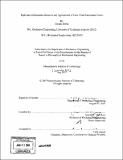| dc.contributor.advisor | Gareth H. McKinley. | en_US |
| dc.contributor.author | Bettin, Giorgia | en_US |
| dc.contributor.other | Massachusetts Institute of Technology. Dept. of Mechanical Engineering. | en_US |
| dc.date.accessioned | 2008-11-10T19:58:38Z | |
| dc.date.available | 2008-11-10T19:58:38Z | |
| dc.date.copyright | 2007 | en_US |
| dc.date.issued | 2007 | en_US |
| dc.identifier.uri | http://hdl.handle.net/1721.1/42285 | |
| dc.description | Thesis (Ph. D.)--Massachusetts Institute of Technology, Dept. of Mechanical Engineering, 2007. | en_US |
| dc.description | Includes bibliographical references (p. 169-174). | en_US |
| dc.description.abstract | The need for smarter and adaptive, energy absorption materials especially for human protection applications has fueled the interest in new and alternative energy absorbing composites. In this thesis a 'novel' energy absorbing fluid-composite that utilized a shear thickening fluid is developed. Shear-thickening fluids are a class of field responsive fluids that have the ability to transition from a low viscosity state to a high viscosity state under an imposed deformation field. A shear thickening fluid composed of silica monodisperse spherical particles of 0.3 ± 0.03 /anm diameter dispersed in ethylene glycol at volume fractions up to = 60% has been characterized. The behavior of the silica suspensions is studied under steady shear, small and large amplitude oscillatory shear flow and also in transient extensional flow. Oscillatory experiments indicate that both the onset and magnitude of the shear thickening depends on the frequency and strain applied and show that rapid time-varying deformations result in maximum energy dissipation. Two different regimes are observed in extensional flow measurement: at low extension rates the suspensions respond as a viscous rate-thinning fluid, whereas beyond a critical extension rate, the suspension strain-hardens and ultimately fractures in a solid-like fashion. Polyurethane open cell or 'reticulated' foam with a relative density of 0.03 and average cell size of 360 rpm is chosen to envelop the concentrated silica suspensions. The behavior of this nonlinear fluid-solid composite is studied over a range of filling fractions under quasi-static deformation rates (strain rates between 10-2 - 1 s-1), under dynamic impact loading (with energy densities of e = 105 - 106 J/m3) and under high strain-rate deformations (strain rates up to 800 s-'). | en_US |
| dc.description.abstract | (cont.) Results show that, if the foam is filled with a shear thickening suspension, the composite stiffens even at strain rates of 10-2 s-1 as the impregnated fluid shear-thickens due to the high local strain rates that develop on cellular length scales. Experiments at high impact loadings revealed two different mechanisms for energy absorption: at low impact energies viscous dissipation is dominant; whereas after a critical impact energy is reached, the fluid undergoes a transition from liquid-like to solid-like. High-speed digital video-imaging shows that cracks form and propagate through the sample and the impact energy is absorbed by viscoplastic deformation. Potential applications for this fluid-solid composite include Traumatic Brain Injuries (TBI) protection and Primary Blast Injuries (PBI) mitigation. Traumatic Brain Injury (TBI) is a serious and potentially fatal injury that results from rapid accelerations of the head, and subjects the brain to high intracranial pressure and shear stresses. To reduce TBI damage, one needs to reduce the magnitude and rate of increase of the intracranial overpressure created by blasts or impacts and subsequent accelerations of the head. We investigated the use of the shear-thickening fluid-based composite to mitigate TBI and we found that through the mechanism of viscoplastic deformation, with solidification and shear banding, the composite was able to absorb large amount of energies (106 J/m3) and still maintain stresses below critical levels. Additionally, the energy absorbing properties of the composite were found to be independent of the magnitude of the incoming energy. Blast injuries are caused by high rate loading of the chest cavity after impact from a blast wave. | en_US |
| dc.description.abstract | (cont.) The resultant pressure wave is transmitted and reflected inside the chest cavity where, at certain points, the pressure gradient became too big for the alveoli to sustain resulting in bursting and bleeding. A shock tube apparatus has been used to test the material response of the STF based composite. Single layer geometries have shown to provide some protection but they also always induced a magnification of the peak pressure which is related to the weight of the samples. A sandwich geometry formed by layering fluid-filled foam facing the incoming wave backed by unfilled foam is found to reduce the rate of pressure rise by 3 orders of magnitude. This behavior can be well described by a double spring-mass-damper system. The layered composite is found to respond linearly with increases in incoming pressure, as the rate of pressure rise has a linear relationship with the magnitude of the incoming pressure. The results found in this study suggest that the STF based composite is an excellent candidate for use in applications of both TBI protection and PBI mitigation. | en_US |
| dc.description.statementofresponsibility | by Giorgia Bettin. | en_US |
| dc.format.extent | 174 p. | en_US |
| dc.language.iso | eng | en_US |
| dc.publisher | Massachusetts Institute of Technology | en_US |
| dc.rights | M.I.T. theses are protected by
copyright. They may be viewed from this source for any purpose, but
reproduction or distribution in any format is prohibited without written
permission. See provided URL for inquiries about permission. | en_US |
| dc.rights.uri | http://dspace.mit.edu/handle/1721.1/7582 | en_US |
| dc.subject | Mechanical Engineering. | en_US |
| dc.title | High-rate deformation behavior and applications of fluid filled reticulated foams | en_US |
| dc.type | Thesis | en_US |
| dc.description.degree | Ph.D. | en_US |
| dc.contributor.department | Massachusetts Institute of Technology. Department of Mechanical Engineering | en_US |
| dc.identifier.oclc | 232156056 | en_US |
